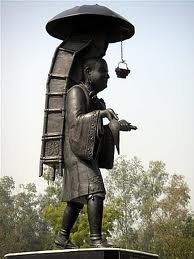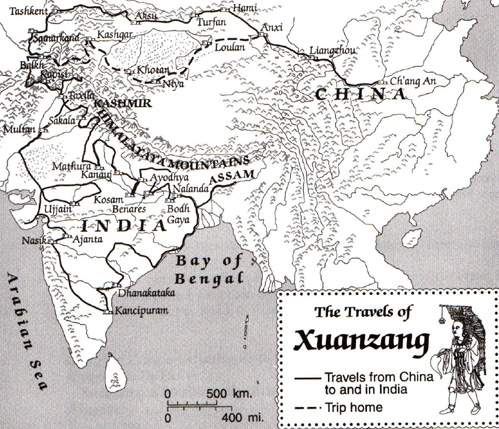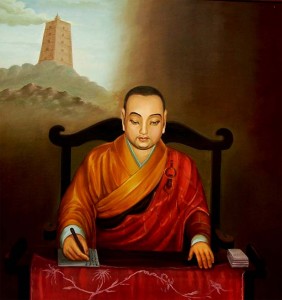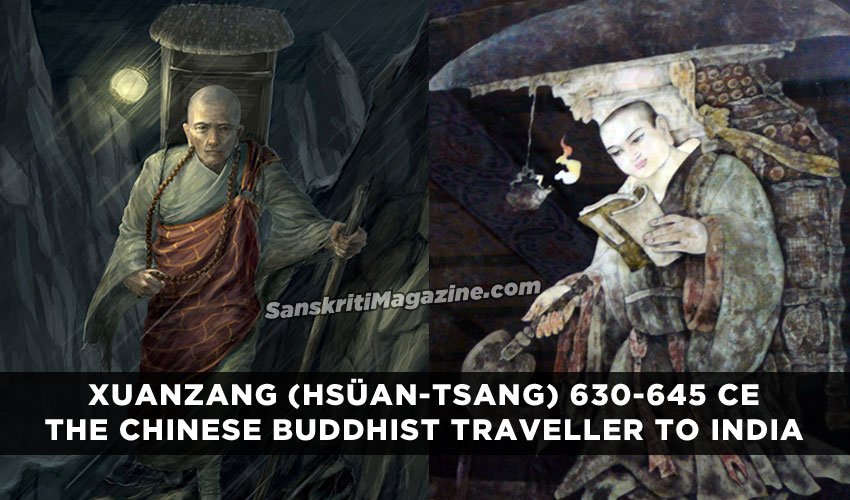Xuanzang, world-famous for his sixteen-year pilgrimage to India and career as a translator of Buddhist scriptures, is one of the most illustrious figures in the history of scholastic Chinese Buddhism.
Born of a family possessing erudition for generations in Yanshi prefecture of Henan province, Xuanzang, whose lay name was Chenhui, was the youngest of four children. His great-grandfather was an official serving as a prefect, his grand-father was appointed as Professor in the National College at the capital, and his father was a Confucianist of the rigid conservative type who gave up office and withdrew into seclusion to escape the political turmoil that gripped China at that time. According to traditional biographies, Xuanzang displayed a precocious intelligence and seriousness, amazing his father by his careful observance of the Confucian rituals at the age of eight. Along with his brothers and sister, he received an early education from his father, who instructed him in classical works on filial piety and several other canonical treatises of orthodox Confucianism.
 After the death of Xuanzang’s father in 611, his older brother Chensu, later known as Changjie, became the primary influence on his life. As a result, he commenced visiting the monastery of Jingtu at Luoyang where his brother dwelled as a Buddhist monk, and studying sacred texts of the faith with all the ardor of a young convert. When Xuanzang requested to take Buddhist orders at the age of thirteen, the abbot Zheng Shanguo made an exception in his case because of his precocious sapience.
After the death of Xuanzang’s father in 611, his older brother Chensu, later known as Changjie, became the primary influence on his life. As a result, he commenced visiting the monastery of Jingtu at Luoyang where his brother dwelled as a Buddhist monk, and studying sacred texts of the faith with all the ardor of a young convert. When Xuanzang requested to take Buddhist orders at the age of thirteen, the abbot Zheng Shanguo made an exception in his case because of his precocious sapience.
In 618, due to the civil war breaking out in Henan, Xuanzang and his brother sought refuge in the mountains of Sichuan, where he spent three years or so in the monastery of Kong Hui plunging into the study of various Buddhist texts, such as the Abhidharmakosa-sastra (Abhidharma Storehouse Treatise. In 622, he was fully ordained as a monk. Deeply confused by myriad contradictions and discrepancies in the texts, and not receiving any solutions from his Chinese masters, Xuanzang decided to go to India and study in the cradle of Buddhism.
Pilgrimage to India (630-645)
An imperial decree by the Emperor Taizong (T’ai-tsung) forbade Xuanzang’s proposed visit to India on the grounds on preserving national security. Instead of feeling deterred from his long-standing dream, Xuanzang is said to have experienced a vision that strengthened resolve. In 629, defying imperial proscription, he secretly set out on his epochal journey to the land of the Buddha from Chang’an.
Xuanzang reports that he travelled by night, hiding during the day, enduring many dangers, and bereft of a guide after being abandoned by his companions. After some time in the Gobi Desert, he arrived in Liangzhou in modern Gansu province, the westernmost extent of the Chinese frontier at that time and the southern terminus of the Silk Road trade route connecting China with Central Asia. Here he spent approximately a month preaching the Buddhist message before being invited to Hami by King Qu Wentai (Ch’u Wen-tai) of Turfan, a pious Buddhist of Chinese extraction.
It soon became apparent to Xuanzang that Qu Wentai, although most hospitable and respectful, planned to detain him for life in his Court as its ecclesiastical head. In response, Xuanzang undertook a hunger strike until the king relented, extracting from Xuanzang a promise to return and spend three years in the kingdom upon his return. After remaining there for a month more for the sake of the dharma, Xuanzang resumed his journey in 630, well provided with introductions to all the kings on his itinerary, including the formidable Turkish Khan whose power extended to the very gates of India. Having initially left China against the will of the Emperor, he was no longer an unknown fugitive fleeing in secret, but an accredited pilgrim with official standing.
 At long last, Xuanzang reached his ultimate destination, where his strongest personal interest in Buddhism was located and the principal portion of his time abroad was spent: the Nalanda monastery, located southwest of the modern city of Bihar in northern Bihar state. As a far-famed metropolis of Buddhist monastic education, Nalanda was a veritable monastic city consisting of some ten huge temples with spaces between divided into eight compounds, surrounded by a high wall. There were over ten thousand Mahayana monks there engaged in the study of the orthodox Buddhist canon as well as the Vedas, arithmetic, and medicine. According to legend, Silabhadra (529-645), abbot of Nalanda, was considering suicide after years of wasting illness when he received instructions from deities in a dream, commanding him to endure and await the arrival of a Chinese monk in order to guarantee the preservation of the Mahayana tradition abroad. Indeed, Xuanzang became Silabhadra’s disciple in 636 and was initiated into the Yogacara lineage of Mahayana learning by the venerable abbot. While at Nalanda, Xuanzang also studied Sanskrit and Brahmana philosophy. Subsequent studies in India included hetu-vidya (logic), the exegesis of Mahayana texts such as the Mahayana-sutralamkara (Treatise on the Scripture of Adorning the Great Vehicle), andMadhyamika (“Middle-ist”) doctrines.
At long last, Xuanzang reached his ultimate destination, where his strongest personal interest in Buddhism was located and the principal portion of his time abroad was spent: the Nalanda monastery, located southwest of the modern city of Bihar in northern Bihar state. As a far-famed metropolis of Buddhist monastic education, Nalanda was a veritable monastic city consisting of some ten huge temples with spaces between divided into eight compounds, surrounded by a high wall. There were over ten thousand Mahayana monks there engaged in the study of the orthodox Buddhist canon as well as the Vedas, arithmetic, and medicine. According to legend, Silabhadra (529-645), abbot of Nalanda, was considering suicide after years of wasting illness when he received instructions from deities in a dream, commanding him to endure and await the arrival of a Chinese monk in order to guarantee the preservation of the Mahayana tradition abroad. Indeed, Xuanzang became Silabhadra’s disciple in 636 and was initiated into the Yogacara lineage of Mahayana learning by the venerable abbot. While at Nalanda, Xuanzang also studied Sanskrit and Brahmana philosophy. Subsequent studies in India included hetu-vidya (logic), the exegesis of Mahayana texts such as the Mahayana-sutralamkara (Treatise on the Scripture of Adorning the Great Vehicle), andMadhyamika (“Middle-ist”) doctrines.
The name of the Madhyamika School, founded by Nagarjuna (2nd century CE), derives from its having sought a middle position between the realism of the Sarvastivada (Doctrine That All Is Real) School and the idealism of the Yogacara (Mind Only) School. Xuanzang appears to have combined these two systems into each other in a more eclectic and comprehensive Mahayanism. With the approval of his Nalanda mentors, Xuanzang composed a treatise, Hui zong lun (Hui-tsüng-lun or On the Harmony of the Principles), which articulates his synthesis.
At Nalanda, Xuanzang became a critic of two major philosophical systems of Hinduism opposed to Buddhism: the Samkhya and the Vaiseshika. The former was based upon a dualism of Nature and Spirit. The latter was a realist system, immediate and direct in its realism, resting upon the acceptance of the data of consciousness and experience as such: in brief, it was a melding of monism and atomism. Such beliefs were in absolute contradiction to the acosmic idealism of the Buddhist Yogacara, which evenly repelled the substantial entity of the ego and the objective existence of matter. Xuanzang also critiqued the atheistic monism of the Jains, especially inveighing against what he saw as their caricature of Buddhism in terms of Jain monastic garb and iconography.
Xuanzang’s success in religious and philosophical disputes evidently aroused the attention of some Indian potentates, including the King of Assam and the poet-cum-dramatist king Harsha (r. 606-647), who was regarded as a Buddhist patron saint upon the throne like Ashoka and Kanishka of old. An eighteen-day religious assembly was convoked in Harsha’s capital of Kanauj during the first week of the year 643, during which Xuanzang allegedly defeated five hundred Brahmins, Jains, and heterodox Buddhists in spirited debate.
Following these public successes in India, Xuanzang resolved to return to China by way of Central Asia. He followed the caravan-track that led across the Pamirs to Dunhuang. In the spring of 644, he reached Khotan and awaited a reply to his request for return addressed to the Emperor Taizong. In the month of November, Xuanzang left for Dunhuang by a decree of the Emperor, and arrived in the Chinese capital Chang’an the first month of the Chinese Lunar Year 645.
Return to China and Career as Translator (645-664)
Traditional sources report that Xuanzang’s arrival in Chang’an was greeted with an imperial audience and an offer of official position (which Xuanzang declined), followed by an assembly of all the Buddhist monks of the capital city, who accepted the manuscripts, relics, and statues brought back by the pilgrim and deposited them in the Temple of Great Happiness. It was in this Temple that Xuanzang devoted the rest of his life to the translation of the Sanskrit works that he had brought back out of the wide west, assisted by a staff of more than twenty translators, all well-versed in the knowledge of Chinese, Sanskrit, and Buddhism itself. Besides translating Buddhist texts and dictating the Da tang xi yu ji in 646, Xuanzang also translated the Dao de jing (Tao-te Ching) of Laozi (Lao-tzu) into Sanskrit and sent it to India in 647.
His translations may, by and large, be divided into three phases: the first six years (645-650), focusing on the Yogacarabhumi-sastra; the middle ten years (651-660), centering on the Abhidharmakosa-sastra; and the last four years (661-664), concentrating upon the Maha-prajnaparamita-sutra. In each phase of his career as a translator, Xuanzang saw his task as introducing Indian Buddhist texts to Chinese audiences in all their integrity. According to Thomas Watters, the total number of texts brought by Xuanzang from India to China is six hundred and fifty seven, enumerated as follows:
- Mahayanist sutras: 224 items
- Mahayanist sastras: 192
- Sthavira sutras, sastras and Vinaya: 14
- Mahasangika sutras, sastras and Vinaya: 15
- Mahisasaka sutras, sastras and Vinaya: 22
- Sammitiya sutras, sastras and Vinaya: 15
- Kasyapiya sutras, sastra and Vinaya: 17
- Dharmagupta sutras, Vinaya, sastras: 42
- Sarvastivadin sutras, Vinaya, sastras: 67
- Yin-lun (Treatises on the science of Inference): 36
- Sheng-lun (Etymological treatises): 13
The Development of Yogacara
The Chinese Faxiang School, derived from the Indian Yogacara (yoga practice) School, is based upon the writings of two brothers, Asanga and Vasubandhu, who explicated a course of practice wherein hindrances are removed according to a sequence of stages, from which it gets its name. The appellation of the school originated with the title of an important fourth- or fifth-century CE text of the school, the Yogacarabhumi-sastra. Yogacara attacked both the provisional practical realism of the Madhyamika School of  Mahayana Buddhism and the complete realism of Theravada Buddhism. Madhyamika is regarded as the nihilistic or Emptiness School, whereas Yogacara is seen as the realistic or Existence School. While the former is characterized as Mahayana due to its central theme of emptiness, the latter might be considered to be semi-Mahayana to a point for three basic reasons: (1) the Yogacara remains realistic like the Abhidharma School; (2) it expounds the three vehicles side by side without being confined to the Bodhisattvayana; and (3) it does not accent the doctrine of Buddha nature.
Mahayana Buddhism and the complete realism of Theravada Buddhism. Madhyamika is regarded as the nihilistic or Emptiness School, whereas Yogacara is seen as the realistic or Existence School. While the former is characterized as Mahayana due to its central theme of emptiness, the latter might be considered to be semi-Mahayana to a point for three basic reasons: (1) the Yogacara remains realistic like the Abhidharma School; (2) it expounds the three vehicles side by side without being confined to the Bodhisattvayana; and (3) it does not accent the doctrine of Buddha nature.
The other name of the school, Vijnanavada (Consciousness-affirming/Doctrine of Consciousness), is more descriptive of its philosophical position, which in short is that the reality a human being perceives does not exist. Yogacara becomes much better known, nevertheless, not for its practices, but for its rich development in psychological and metaphysical theory. The Yogacara thinkers took the theories of the body-mind aggregate of sentient beings that had been under development in earlier Indian schools such as the Sarvastivada, and worked them into a more fully articulated scheme of eight consciousnesses, the most weighty of which was the eighth, or store consciousness — the alaya-vijnana.
Decline of Faxiang School in China
As an early and influential Chinese Buddhist monk, Xuanzang embodies the tensions inherent in Chinese Buddhism: filial piety versus monastic discipline, Confucian orthodoxy versus Mahayana progressivism, etc. Such tensions can be seen not only in his personal legacies, which include the extremely popular Chinese novel based on his travels, Xiyouji (Journey to the West), but also in the career of scholastic Buddhism in China.
For a time during the middle of the Tang Dynasty the Faxiang School achieved a high degree of eminence and popularity across China, but after the passing of Xuanzang and Kuiji the school swiftly declined. One of the factors resulting in this decadence was the anti-Buddhist imperial persecutions of 845. Another likely factor was the harsh criticism of Faxiang by members of the Huayan (Hua-yen) School. In addition, the philosophy of this school, with its abstruse terminology and hairsplitting analysis of the mind and the senses, was too alien to be accepted by the practical-minded Chinese.
~ Excerpted from Der Huey Lee’s biography of Xuanzang, Peking University











